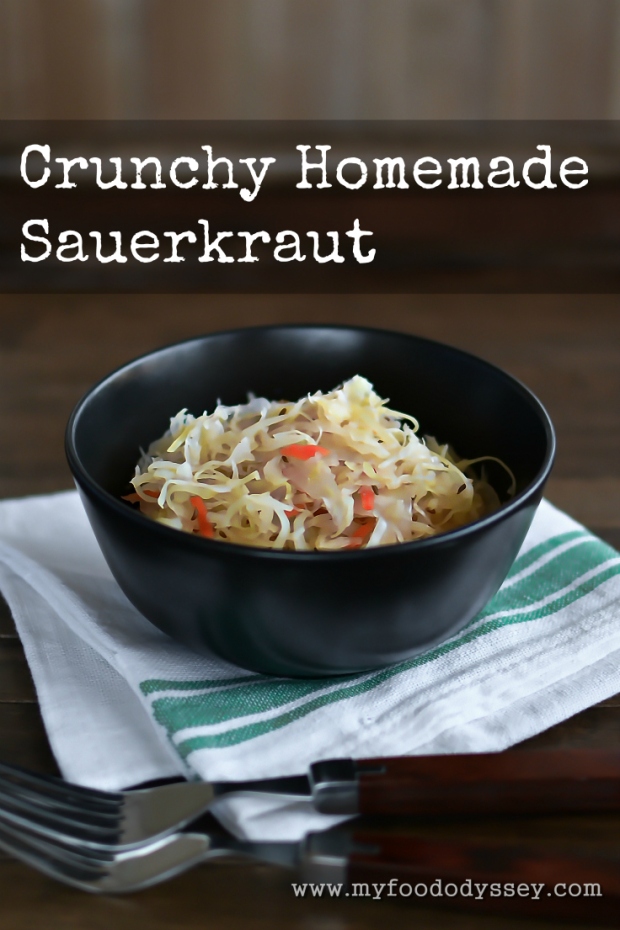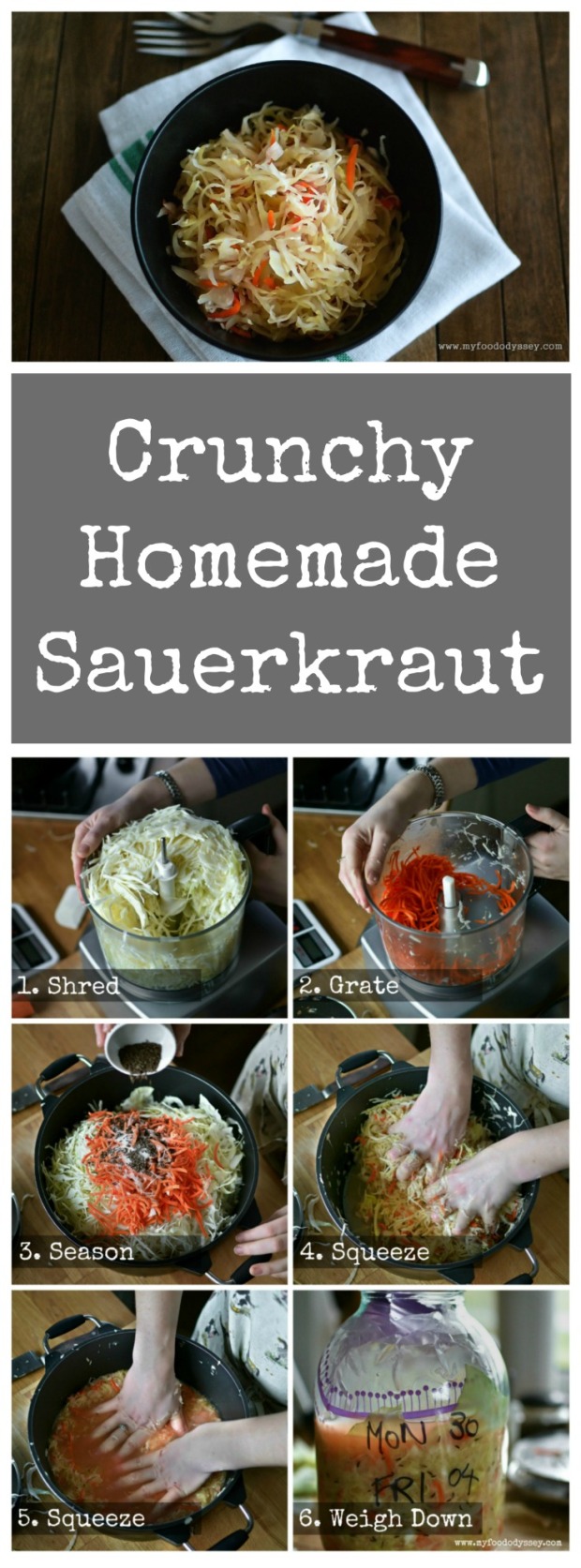Lithuanian Sauerkraut | Rauginti Kopūstai [Recipe]

In our house certain things happen so often that they have been given their own name. One of our most frequent occurrences is “where-is-age”, a phenomenon whereby Arūnas can’t find something he needs, despite the fact that the item is exactly where it’s supposed to be. “Where’s my wallet?” “It’s in the drawer, darling.” (Where it always is.) “Where are my keys?” “They’re in the drawer, darling.” (Where they always are.) You get the gist.
Next on the list is “kickage” (also known as “bounceage”). Arūnas is full of energy and cannot sit or lie still for any length of time, whereas I can sit virtually motionless for long periods, my only movement being the turning of a page or my fingers on the keyboard. His legs appear to have a life of their own, particularly when he’s talking. Unfailingly, they move to the beat of his words. Getting through a movie is a nightmare – the legs are crossed, then uncrossed, then crossed again, then tucked under him, then curled to the side. It drives me bonkers.

And then there’s “pickleage”. Lithuanians love fermented foods, with cucumber pickles, sauerkraut and sour milk or kefir being eaten regularly and in abundance. As luck would have it, I also love fermented foods, so much so that I have a section of my worktop permanently dedicated to fermenting foods. My little fermentation station usually has my sourdough starter, a flask of yogurt and a 3 litre (3 quart) jar of either pickles or sauerkraut. We never, ever run out of fermented vegetables, yet Arūnas still asks at every meal “is there any pickle?”
(I guess I should add that there is also lots of love-age, but we won’t talk about that here.)
When the first snow fell recently I rushed out to rescue what was left of my brassicas. I still had lots of cabbage, kale and sprouts growing and wasn’t sure how the snow might affect them. My cabbages had started the season as show specimens but had, in later months, been decimated by caterpillars. The remaining heads were unattractively moth-holed. By the time the outer leaves were removed they were quite small and didn’t look like they would keep well, so I decided to turn them all into sauerkraut.

Sauerkraut is not a uniquely Lithuanian food, but ingredients do vary from country to country. Traditional Lithuanian sauerkraut contains cabbage, carrot and caraway seeds. Every home cook has their own recipe, but typically there is a much higher proportion of cabbage to carrot. White cabbage is usually used, particularly at this time of year when they are widely and cheaply available.
Sauerkraut is incredibly easy to make – shred or grate your vegetables, add salt and any other seasoning, squeeze the salt into the vegetables to extract the juices and then leave the vegetables, covered in this natural brine, to ferment for several days. There are a few keys to the success of your sauerkraut, though. First and foremost, calculate the quantity of salt carefully. If you want a consistent result you must use a consistent quantity of salt. Estimating the quantity of salt needed will most likely result in a product that is either inedibly salty or limp and bland. I have found that 2% salt works perfectly, giving us a crunchy, tangy sauerkraut typical of what we might buy in the market. If you’re new to sauerkraut-making, I suggest sticking with 2% for the first few batches, and then adjusting up or down to suit your taste.
Your fermentation jar must be spotlessly clean. Fermentation is initiated by organisms naturally occurring on the vegetables, and presence of any competing bacteria may spoil the whole batch. Wash your jar thoroughly with hot, soapy water, rinse well and dry with a fresh cloth. Finally, the fermentation process is anaerobic, meaning it happens in the absence of oxygen. The process does, however, produce gases. Thus, you need to cover your vegetables in such a way that prevents contact with air but allows gases to escape. I find a zip-closure bag perfect for this as it adapts to the size of your jar and the quantity of vegetables. Push the bag down on top of the vegetables, then fill the bag with water to keep the vegetables weighed down under the brine. Any gases produced can escape around the sides of the bag.

Lithuanian Sauerkraut | Rauginti Kopūstai
This recipe is no longer available online. For the full recipe and detailed, step-by-step instructions, please see my cookbook, available from just $2.99 here.
The book contains all of the most popular Lithuanian recipes including cepelinai (potato dumplings), šaltibarščiai (cold beet soup) and kugelis (potato pudding), plus stories from my life in Lithuania and colour photos of the stunning Lithuanian countryside.
To preview the book click here.

NEW! Lithuanian Cookbook:
You can now find all the Lithuanian recipes featured on this site in my new cookbook. This beautiful 77 page book also contains stunning photos of the Lithuanian countryside. Available from just $2.99 here.
.
To preview the book click here.
More Lithuanian Recipes

LITHUANIAN KUGELIS | POTATO PUDDING:
A national dish of Lithuania, kugelis is a rich and hearty potato pudding. My version is made with chicken pieces, which steam inside the potato mixture, making them moist and delicious. (View recipe)

LITHUANIAN CEPELINAI | POTATO DUMPLINGS:
The national dish of Lithuania, cepelinai are hearty, nourishing and delicious. Written for cooks making cepelinai for the first time, this recipe includes step-by-step instructions with photos. (View recipe)

LITHUANIAN COLD BEET SOUP | ŠALTIBARŠČIAI:
This garishly pink soup is both light and nutritious, perfect for warm sunny days or for weekday lunches when your tummy needs a little TLC. (View recipe)

LITHUANIAN KOLDŪNAI | MEAT DUMPLINGS:
These delicious dumplings are the perfect comfort food – quick to cook, mild in flavour and served with a dollop of sour cream and a salty bacon and onion topping. (View recipe)

LITHUANIAN BALANDĖLIAI | CABBAGE ROLLS:
Another of Lithuania’s national dishes, these cabbage rolls are stuffed with seasoned ground pork and served with a creamy, tangy tomato sauce. Recipe includes step-by-step photos. (View recipe)
![Curd Cheese Doughnuts | Varškės Spurgos [Recipe]](https://junesfoododyssey.files.wordpress.com/2015/11/curd-cheese-doughnuts-varske-spurgos-dsc_0141-1.jpg?w=150&h=112)
LITHUANIAN CURD CHEESE DOUGHNUTS | VARŠKĖS SPURGOS:
These Lithuanian-style doughnuts are light and airy and not at all cheesy! They do not require yeast and so are quick and easy to prepare. (View recipe)
Like what you see? Then please subscribe to My Food Odyssey. For updates on my daily life you can follow me on Facebook, Twitter and Pinterest.
INGREDIENTS: 2 kg | 4.5 lb head white cabbage 200 g | 7 oz carrot (1 medium carrot, approx)
40 g | 1.5 oz fine salt (or 2% total prepared vegetable weight) 10 g | 1 Tbsp caraway seeds METHOD: Peel the carrot. Remove any damaged outer leaves from the cabbage, rinse the whole cabbage under running water and then cut the cabbage into pieces that will fit through the funnel of your food processor, discarding the solid heart. (You can use a coarse grater for the carrot and a mandolin slicer for the cabbage if you don’t have a food processor.) Weigh the cabbage pieces and the peeled carrot and calculate the exact quantity salt required – 20 g of salt per kilo (1/3 oz per pound) of prepared vegetables. The sourness of your final sauerkraut depends on the quantity of salt used, so for consistent results do spend a little time calculating this weight correctly. Shred the cabbage using your food processor’s fine slicing disc. Transfer to a large saucepan or food grade bucket. (I use a 7 litre | 7 quart stew pan.) Grate the carrot using your food processor’s coarse grating disc and add to the cabbage. Add the salt and caraway seeds. Using your hands, mix the ingredients together and begin to squeeze and massage the vegetables. After just a few minutes you will see liquid starting to come out of the vegetables and notice that the volume of the vegetables is reducing. Continue to squeeze until the vegetables are fully covered with liquid when pressed down firmly. (See photograph.) Transfer the mixture to a clean 3 litre | 3 quart jar. Push the mixture tightly down into the jar until the liquid just covers the top of the vegetables. Fit a 2.5 litre (3 quart) zip-closure food bag into the top of the jar. Put your hand into the bag and push the bag down onto the vegetables and right out to the sides of the jar. Carefully fill the bag with water and zip it closed. The bag will act as a weight to keep the vegetables under the brine and will keep insects and dust out of the jar, but will allow gases that are created during fermentation to escape. If you don’t have a large enough jar you can leave the vegetables in the saucepan or bucket, weighing the mixture down with a plate and covering with a clean tea cloth. Label the jar with the date so you know when fermentation began. Set the jar on a plate or tray (as some liquid may bubble out during fermentation) and leave at room temperature for a minimum of 5 days. After 5 days test the sourness of your sauerkraut. If it is not quite sour enough, refit the bag and allow to ferment for a further 2-3 days. If you are happy with the sourness you can transfer the sauerkraut to clean jars or zip-closure bags. Zip-closure bags are ideal as they can be squeezed to remove any air before sealing, regardless of whether or not the bag is full. If using jars, pack the jar as tightly as possible, leaving just a small head space (½ cm | ¼ inch) at the top to minimise air contact. We go through quite a bit of sauerkraut so I find that 1 litre (1 quart) bags works well for our needs. However, if you only use a little at a time I would recommend storing it in smaller quantities as sauerkraut begins to deteriorate once it is exposed to air. Your sauerkraut will keep for several months if stored in the fridge. It will continue to sour a little as time progresses.
Trackbacks & Pingbacks
- Half-Sour Pickles | Rauginti Agurkai [Recipe] | My Food Odyssey
- Lithuanian Kugelis | Potato Pudding | My Food Odyssey
- Lithuanian Christmas Eve Biscuits | Kūčiukai [Recipe] | My Food Odyssey
- Curd Cheese Doughnuts | Varškės Spurgos [Recipe] | My Food Odyssey
- Lithuanian Koldūnai | Meat Dumplings [Recipe] | My Food Odyssey
- Lithuanian Cold Beet Soup | Šaltibarščiai [Recipe] | My Food Odyssey
- Cepelinai for Beginners [Recipe] | My Food Odyssey
- Lithuanian Cabbage Rolls | Balandėliai [Recipe] | My Food Odyssey



































Your pictures are so great! I love recipes that include beautiful and informative pictures that help guide you along the way in following them. Can’t wait to try this recipe at home! Thank you for sharing! I’ll report back after I’ve made it and hopefully ended up with as beautiful a product as you showed!
LikeLike
What do you do with the lovage? I have it growing in abundance, but I am aware of only limited uses – mainly in salads and with potatoes.
LikeLiked by 1 person
Hi Stephanie! My use of the word “lovage” was actually a play on words, like the other words I made up in the post (where-is-age, kickage, etc.) It really just means “love”. 😉
Unfortunately I’ve never eaten lovage and can’t recommend what to do with it.
LikeLike
my mom worked for a lady that made it using sauerkraut and cabbage with pork they used country ribs or chops carrots tomatoes caraway. do you know of anyone with a recipe like that. This lady escaped Lithuania as a child. I would love that recipe
LikeLiked by 1 person
Hi Sandy. I do make a soup with sauerkraut and ribs and often use sauerkraut as a garnish on the side of pork dishes. I will be sharing some of these recipes over the coming months. I’m not sure if they’re exactly what you’re looking for, but hopefully they’ll be of use.
LikeLiked by 1 person
This looks delicious, but I would love to see the recipe for your sauerkraut soup, too. I just tried it for the first time on a visit to Vilnius and loved it!
LikeLiked by 1 person
Hey Larissa! I keep meaning to do the soup recipe – I will get round to it eventually. It’s one of my favourites, that I cook quite regularly. In a nutshell I use 500 g (1 lb) sauerkraut to 2 litres/quarts of water. It needs to simmer for at least 2 hours to get that lovely sour taste into the soup. I usually make mine with smoked sausages – about 500 g of cold smoked pork sausage, cut into thick slices. I put these in quite early – I start prepping as soon as the soup is boiling. The potatoes I cook separately. I use about 300-400g (about 3 medium potatoes), peeled and diced into 1 cm (1/2 inch) pieces. They won’t cook in the soup because of the acid in the sauerkraut, so cook them separately and add them to the soup before serving to reheat, or serve them on the side. Hope that helps!
LikeLiked by 1 person
Thanks so much for the soup recipe (and for posting it so quickly)! I live in Iceland, so this is just the type of warming soup that I need for the wet, dreary days of February. Ačiū!
LikeLiked by 1 person
did you ever find the recipe or method? my late mom used to make spareribs and sauerkraut too and I have never found a recipe.
LikeLike
Hey Jackie,
I’d actually included the recipe in one of the earlier comments. Sorry that it’s not as clear as my usual recipes. Here it is again, laid out a bit better.
Makes 6 bowls.
Ingredients:
500 g | 1 lb sauerkraut
2 litres | 2 quarts cold water
500 g | 1 lb cold smoked sausage (or pork ribs, if you prefer)
3 medium potatoes (about 300-400 g), cut into half-inch cubes
Method:
1. Put the sauerkraut and water into a large (3 litre/quart) saucepan.
2. If using smoked sausauge, cut into bite-sized slices and add to the pot. If using ribs, cut into individual ribs and brown in a little oil in a separate hot pan for about 5 minutes, then add to the soup.
3. Bring to the boil, cover with a lid and simmer gently for about 2 hours.
4. About 30 mins before serving place the potato chunks in a separate saucepan, cover with water and bring to the boil. Cover with a lid and simmer for 5-7 minutes until tender.
5. Strain the potatoes and add to the soup.
6. Serve and enjoy!
Hope that helps! June.
LikeLike
My family is also from Lithuania and the caraway was just the recipe I was looking for. Thank you!
LikeLiked by 1 person
Brilliant June! I’ve been wanting to have a go at this for just about ever. Couldn’t be more timely as my beautiful cabbages have been smitten by some kind of rot and I’ve got to pull the lot. Shall most definately be trying this. Thankyou! 😀
LikeLiked by 1 person
It’s a great way to salvage cabbages that are on the brink so they don’t go to waste. And with so many uses – you won’t be sorry!
LikeLiked by 1 person
My mom and grandma always added some cranberries to the sauerkraut mix, and that was the best thing about this food, ’cause I really did not like this particular food at all. And I believe sometimes sugar or some honey also went in to either make the fermentation faster, either to get a ‘softer’ flavor. Silly me as a kid for not liking sauerkraut 🙂
LikeLiked by 1 person
I’ve seen a few recipes with cranberries, Asta, but I just can’t imagine how they would work. I’ll have to find someone who makes it this way and try theirs. I also don’t like any sweet things in my fermented veg, but that could be just taste. I know lots of people put sugar in pickles so I can image some putting it in sauerkraut, too. Some krauts are way too cabbagy, which I think can be off-putting, especially to a kid. I’ve given a recipe here for the typical kraut I find in the markets but I actually prefer mine made with softer cabbages such as Savoy because they taste sourer and less cabbagy. Even a 50/50 mix (white to green cabbage) works well. But my husband loves this version – it’s the stuff he grew up with. There just ain’t no accounting for taste!
LikeLiked by 1 person
Carrot in sauerkraut. Sacrilege! …but it does kinda look very good… hmmmm.
LikeLiked by 1 person
It’s interesting how traditional recipes vary from country to country. When I was researching the post I noticed that Germans typically use only cabbage. The carrot gives a nice blast of colour and sweetness once there isn’t too much of it. Worth a try, methinks!
LikeLike
My parents used to add juniper berries and bay leaf when serving it warm with pork sausages.
LikeLiked by 1 person
I love it that way, too. Reminds me of the cans of Alsatian choucroute garnie we used to buy when we were camping in France years ago.
LikeLike
It must be very refreshing, when the staple food with meat. 🙂
LikeLiked by 1 person
Looks lovely! I am obsessed with kraut! 🙂 Good post!
LikeLiked by 1 person
Hm, I’m intrigued to try making sauerkraut. I hated it as a child but really, that is a long time ago. I also hated pickles as a child and over them now!
LikeLiked by 1 person
If you’re not a huge fan of sauerkraut, Vilma, but like pickles, then I suggest making it with a soft, loose-leaf cabbage like Savoy rather than a compact head of white cabbage. The softer leaves take on the sourness more readily and have less of a cabbagy taste – it’s more like pickle than sauerkraut.
LikeLiked by 1 person
What a great tip, thank you!
LikeLiked by 1 person
Have you tried the sauercraut ( never kniw how to spell it) warm salad? Make soft some chopped onions in a tournesol oil and pour the full mix on sauercraut…mmmm with hot patatoes and some bacon – not compulsory lol… Memories from a chidhood…
LikeLiked by 1 person
Sounds delicious, Inga. Bacon is pretty much compulsory with everything here – it’s one of the reasons I stayed! 😉
LikeLike
I enjoy sauerkraut but only a little at a time. There’s a BBQ joint near my house that give you a big pile but I’d rather just a small amount to go with the meats. I think making my own would be better as I could ration it out better and just enjoy a little at a time. Thanks for sharing this traditional Lithuanian recipe.
This post would make a great submission to Our Growing Edge, which is a link up party for new food adventures. This month’s theme is “Nostalgia”. More info here: http://bunnyeatsdesign.com/our-growing-edge/
LikeLiked by 1 person
Thanks for the link suggestion, Genie – I’ll take a look. I hope you get to try the recipe – somehow it’s so much nicer when you’ve made it yourself!
LikeLike
I’ve eaten sauerkraut of course but never made it …. you inspire me to have a go, not least because your pictures make it look SO appetising which is unique in my experience – every recipe I have ever seen managed to make it look far from enticing. Chapeau m’dame!
LikeLiked by 1 person
It is kinda tricky to get fermented cabbage to look appealing – those photos took quite a bit of time. All time well spent, though, if you’re inspired to give it a go! It really is easy and has so many uses – I just love the stuff!
LikeLiked by 2 people